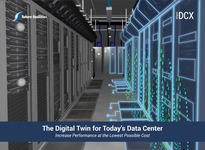Problems around wasted capacity and budgetary constraints on data center infrastructure have long been a cause for cold sweats in the middle of the night. Pressure on the data center was already high, but now these problems have become living nightmares. For operations directors, they are caught between a rock and a hard place. On the one hand, they need to respond to capacity demands quickly, and on the other maintain reliability and use capacity efficiently. Failure to meet any one of these requirements puts operations immediately at risk of losing customers to competitors.
Worryingly for operations directors is the news that reports from the Uptime Institute have uncovered that 78 percent of organizations have had an IT service outage in the past three years – with larger outages happening more frequently, and becoming much more damaging. The overall cost to businesses is high, in terms of customer satisfaction and loyalty. All of which hurts a business’s profit margins. What perhaps is most worrying, is that when questioned, operators admit the majority of outages were their fault. In fact, three out of four said that with hindsight, their most recent major outage was preventable. Each outage pushes capacity demands towards competitors and reduces the value a particular data center can offer.
The chances and risk of outage though are likely to only increase thanks to the global pandemic. With new restrictions in place, it is likely to continue to cause larger outages if planning and maintenance of a data center continue to go unchecked. And while the reality is that many businesses were unprepared for the first set of lockdowns, that cannot be the case going forward.
Every detail counts
In the Spring, as it became apparent how the widespread impacts of Covid-19 would be on businesses, Gartner asked organizations whether they were ready to deal with it. The answer? As it turns out, not many. Just 12 percent confirmed they felt prepared. And yet, if those same firms were asked today whether they have planned for any further disruption to business as part of their core strategy, the numbers have to be a lot higher.
At the same time that Gartner identified the lack of preparation for Covid-19 from the business as a whole, Accenture identified that even less - only 10 percent - of organizations felt they had truly resilient systems in place. Rather than focusing on new deployments and adding extra capacity, the new reality is instead making sure that systems and infrastructure are resilient enough for the uncertainty and challenges ahead. Previously a highly unsexy topic, always at the edges of board meetings, the pandemic has brought it into the limelight. Measuring, modelling and predicting is now more important than ever as they are rightly discussed at the higher echelons in many businesses.
Showcase the facility’s value
Managing the data center has always involved using key analytics – a long proven capability. However, recent developments in today’s technologies are far more refined, and better-suited to the economic landscape in which we have found ourselves. The latest technologies no longer provide basic insights on how a data center is operating and instead create highly accurate interactive models of a data center. This is the Digital Twin.
The concept of the Digital Twin was being used by NASA as early as the 1970s for the Apollo 13 mission, as scientists questioned how they could operate, maintain and repair systems when they weren’t within physical proximity to them. Today, it is used in multiple high tech industries such as aerospace. It has evolved and shifted into the data center realm allowing businesses to identify and exploit stranded capacity and making it even more accessible to those looking to unlock the full potential of their infrastructure. It allows teams to analyse, model and test all preferred scenarios in a risk-free environment across the data center industry. By providing a virtual replica of the real data center facility, it enables operators to fully explore the true capacity availability at their businesses disposal.
This can have a profound impact on the cost of delivering business needs. The Digital Twin provides the exact visibility and analytics needed to minimise risk, keep a tight rein on costs and maximise the business potential that is now in demand. Right now, there has never been a time where the utilization of risk and cost have been more important for data center and business. While being unprepared was understandable with the first round of lockdowns, nearly nine months on that is no longer the case. The technology and solutions are here to help and it is time to make sure they are in place.





